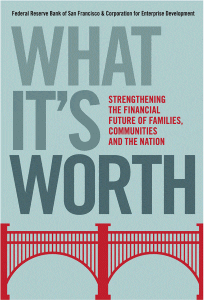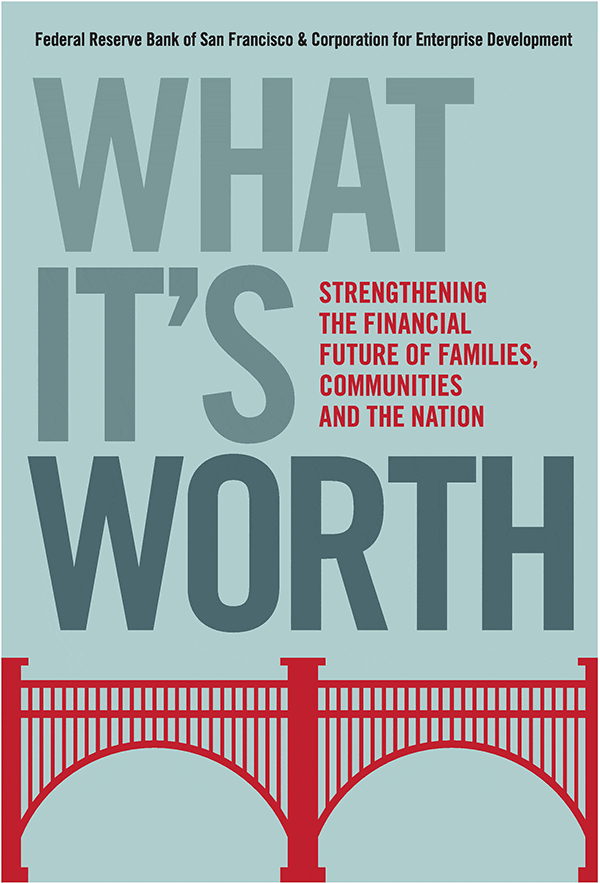
As the volume’s contributors explain, financial capability focuses our attention on how society equips individuals with knowledge and skills to better interface with our financial system, and how we work to ensure that a range of beneficial financial products and services exist to present those individuals with enough options to achieve stability and meet their goals in life. On the other hand, financial well-being, a newer term, places more emphasis on key outcomes for households, such as the ability to weather financial shocks and meet financial goals over time. In order to achieve financial well-being, people have to rely on their own financial capability, more than they did even a generation or two ago, by navigating an increasingly complex financial services marketplace. This is due in part to factors such as the decline of stable, family-supporting employment; the shift from defined benefit pensions to 401(k) plans; the skyrocketing costs of higher education that is pushing people into the choppy waters of student loans; the growing use of credit scores as a gatekeeper for employment, housing, reasonably priced insurance, and credit; and last but not least, the retreat of the neighborhood branch bank or credit union (pp. 13-32).
In Jared Bernstein’s chapter, we learn that there is reason to believe the dynamic works in both directions. Not only does the financial health of households depend on their ability to navigate our financial services marketplace, but the greater the number of households and communities that fail to achieve financial well-being and stability, the more likely it is that negative repercussions will be fed forward through our economy, with negative systemic consequences (pp.72-84). Seidman summarizes this key point well when she says, “household financial health and well-being is the bridge to a better life, a better community, and a better economy.”
What’s more, as several contributors point out, it makes a great deal of difference just which individuals and communities we have in mind as we focus on the intersection between an increasingly complex and unstable financial system, and the increasing necessity to navigate it to achieve financial stability. If we have in mind only those individuals who start out with some level of prosperity and privilege, then it’s much less likely that our products, services, policies, and prescriptions will fit the needs and capacities of those who have the furthest to travel toward prosperity, and whose productive capacities are critical to our shared success and stability as a nation.
That’s why a number of the authors conclude that we must invest more resources, for instance, with African-American households hamstrung by generations of wealth stripping and outright discrimination, and by the financial consequences of being targeted by the criminal justice system (See Vivian Nixon and Susan Sturm’s chapter on mass incarceration, pp. 187-195, and Dedrick Asante-Muhammad’s essay, pp. 251-260). And, I would add, we must make sure that African-American practitioners and leaders are at the center of crafting and carrying out those investments and interventions. Likewise, we must work harder to serve and invest in millions of Latino households, for whom the financial consequences of living in the shadows outside formal citizenship may be just as damaging as the political, civic, and social consequences (Robert Friedman, p. 383). A good place to start is with leaders who are in deep relationship with those communities, like José Quiñonez of Mission Asset Fund (pp. 261-270). Likewise, we can follow the lead of Elsie Meeks of the Lakota Funds, a trailblazer in the field serving and investing in Native American communities across the country (pp. 271-276), and of Lisa Hasegawa and Jane Duong of the National Coalition for Asian Pacific American Community Development (pp. 277-284).
Several contributors mention rural issues, but I believe the topic could have benefited from at least one more focused essay. More attention to the issues faced by rural communities in the United States is warranted. In Minnesota, many rural communities were ravaged by the farm foreclosure crisis of the 1980s; many are experiencing new waves of immigration that bring new needs, social pressures, and economic and entrepreneurial vitality with them. Rural communities are also less able to deal with waves of de-industrialization and the withdrawal of branch financial institutions in recent decades.
Friedman, CFED’s founder, gets the last word as he articulates one of the boldest lines of analysis and critique that the organization has marshaled over the last few years, together with the Tax Alliance for Economic Mobility. “The United States has a large existing tax policy to encourage asset-building—more than half a trillion dollars in annual income tax expenditures is devoted to subsidizing homeownership, retirement savings, higher education, business investments, and other types of assets . . . however . . . 90 percent of Americans cannot take advantage of their share of this national investment. The system is regressive, wasteful, and counterproductive . . . (instead, we must) convert America’s annual investment in inequality into an investment in the productive capacity of the American people.” (pp. 390-91).
What It’s Worth makes a broad and powerful case for connecting a set of financial capability skills with the right kinds of financial products and services at the right moments during the financial lifecycle of our clients and our communities. It highlights the importance of integrating those interventions with the work of new partners in the fields of education, criminal justice reform and re-entry, health care, and social services, as well as across public, private, and non-profit sectors. This whole set of interventions and goals should be connected to an approach that genuinely incorporates racial and geographic equity, not simply by slogan or as an afterthought. Are we a field? Are we a movement? I say we need to be both. This compilation of essays makes a good case for why we need all hands on deck for the journey.





Comments